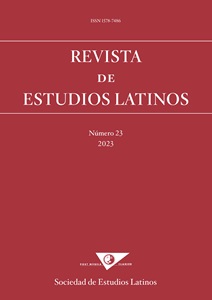The Latin Gausăpa “Woollen Cloth”. Origin, Polysemy and Continuity in Romance
DOI:
https://doi.org/10.23808/rel.v23i0.103226Keywords:
Greek loan, Iranian origin, paronymy, metaphor, metonymyAbstract
Gausăpa “woollen cloth, shaggy on one side” is a loan from Gr. ὁ γαυσάπης introduced in the feminine by Varro. There are several hypotheses about its origin, but the common consensus is that the term comes from Iran, where a sequence of empires traded with the Mediterranean. In our analysis of gausapa, we consider two other loanwords, also received from Greek: gossypion “cotton (plant)” and gaunăca “Persian cloak”. Both help us to confirm the Iranian origin of gausapa, which enjoyed splendour as a garment in the time of Augustus; but from the second century onwards there is a sharp decline in its use. The gaunaca which is referred too in literature from Varro onwards did not enjoy the same glamour; instead, it survived better as a coat. Both paronyms crossed their expressions in late and early medieval Latin to the detriment of gausapa. However, this word, which was used in Persius to denote the beard and the wig, travelled a productive metaphorical and metonymic journey in popular language from Petronius onwards. The noun and its two adjectives, gausapatus and gausapĭnus, came to designate the live young of mammals, their tender meat, their fine skin and, closing the circle, items of clothing again. It is certainly urprising that the continuity of these metaphors in Romance has remained unnoticed until this century.
Downloads
References
CAD = The Assyrian Dictionary , Vols. i–xxvi, (1955…), Chicago, IL, The Oriental Institute of the University of Chicago.
Chantraine, P. (1962): Dictionnaire étymologique de la langue grecque, París, Klincksieck.
Chillet, C. (2016): De l’Étrurie à Rome. Mécène et la fondation de l’Empire, Rome, Publications de l’École française de Rome.
CORDE: Real Academia Española, Corpus diacrónico del español. ‹http://www.rae.es› [05/10/2023].
Cresci Marrone, G. (2022): «Guerra di statue in età triumvirale», en Cassia, M. & Arena, G. (eds.), Res et verba. Scritti in onore di Claudia Giuffrida, Milán, Mondadori, 124–143.
Daremberg, Ch. & Saglio, E. (1969 [1881]): Dictionnaire des antiquités grecques et romaines, Graz, Akademische Verlagsanstalt.
DCECH = Corominas, J. & Pascual, J. A. (1980): Diccionario crítico etimológico castellano hispánico, Madrid, Gredos.
DGE = Rodríguez Adrados, F. et al.: Diccionario Griego-Español, Madrid, CSIC. ‹http:/dge.cchs.csic.es/xdge› [11/09/2023].
DLE = Real Academia Española (2014 23a ed.): Diccionario de la lengua española, Madrid, Espasa-Calpe. ‹https://dle.rae.es› [06/10/2023].
Ernout, A. & Meillet, A. (2001 [1985]): Dictionnaire étymologique de la langue latine, París, Klincksieck.
Forcellini, A. (1965 [1771]): Lexicon totius latinitatis, Bolonia, Forni.
García de Diego, V. (1985): Diccionario etimológico español e hispánico, Madrid, Espasa-Calpe.
García-Hernández, B. (2006): «El origen latino de jabato, gabato y gazapo», Revista de Filología Española 86, 277–292.
García-Hernández, B. (2007): «Lat. apros gausapatos (Petr. 38.15), esp. jabatos. El romance en auxilio del latín», en Hinojo Andrés, G. & Fernández Corte, J. C. (eds.), Munus quaesitum meritis. Homenaje a Carmen Codoñer, Salamanca, Ediciones Universidad de Salamanca, 369–378.
García-Hernández, B. (2013): «Innovaciones latinas y románicas en el campo léxico de sūs (“cerdo”)», en Casanova Herrero, E. & Calvo Rigual, C. (eds.), Actas del XXVI Congreso Internacional de Lingüística y de Filología Románica, vol. iv, Berlín, De Gruyter, 543–550.
García-Hernández, B. (2016): «La evolución del significado y la transformación de la expresión. Del frasema y la composición al morfema preverbial y sufijal», en García-Hernández, B. y Penas Ibáñez, A. (eds.), Semántica latina y románica. Unidades de significado conceptual y procedimental, Berna / Berlín, Peter Lang, 135–158.
Glare, P. G. W., ed. (1985): Oxford Latin dictionary, Óxford, Clarendon Press.
Hemmerdinger, B. (1970): «De la méconnaissance de quelques étymologies grecques», Glotta 48, 40–66.
Heraeus, W. (1937): «Die Sprache des Petronius und die Glossen», en Hofmann, J. B. (ed.), Kleine Schriften, Heidelberg, Winter, 52–150.
Ivantchik, A. I. (1993): Les Cimmériens au Proche-Orient, Göttingen, Vandenhoeck & Ruprecht.
Jokl, N. (1984): Sprachliche Beiträge zur Paläo-Ethnologie der Balkanhalbinsel, Viena, Verlag der Österreichischen Akademie der Wissenschaften.
Lewy, H. (1931): «Etymologien: 15. γαύσαπος und lat. gossypium», Zeitschrift für vergleichende Sprachforschung 58, 26–28.
Lüders, H. (1936): «Textilien im alten Turkistan», Abhandlungen der preussischen Akademie der Wissenschaften Jahrgang 3, 3–38.
Macía Aparicio, L. M., trad. (1993): Aristófanes, Comedias II, Madrid, Ediciones Clásicas.
Meyer-Lübke, W. (1972): Romanisches etymologisches Wörterbuch, Heidelberg, Winter.
Potthoff, A. (1992): Lateinische Kleidungsbezeichnungen in synchroner und diachroner Sicht, Innsbruck, Universität Innsbruck.
RE VII 1 (1910): Paulys Real Encyclopädie, Stuttgart, Metzler.
Rundgren, F. (1960): «Griech. βατιάκη, Linear A pa-ta-qe», Glotta 38, 10–14.
Schmitt, R. (1967): «Griechisch μανιάκης, ein iranisches Lehnwort», Sprache 13, 61–64.
Schmitt, R. (1971): «“Méconnaisance” altiranischen Sprachgutes im Griechischen», Glotta 49, 95–110.
Schwyzer, E. (1928): «Iranisches. 2. Γαυνάκη(ς) der farbige Perser-Flaus», Zeitschrift für Indologie und Iranistik 6, 234–43.
Schwyzer, E. (1968): Griechische Grammatik I, Múnich, Beck.
Sullivan, J. P. (1985), «Petronius’ Satyricon and its Neronian Context», ANRW II 32. 3, 1666–1686.
TLL = Academiae quinque Germanicae (1900…), Thesaurus linguae Latinae, Leipzig, Teubner / Berlín, De Gruyter.
Velázquez Soriano, I. (2004): Las pizarras visigodas (Entre el latín y su disgregación. La lengua hablada en Hispania, siglos VI–VIII), Madrid - Burgos, Real Academia Española - Instituto Castellano y Leonés de la Lengua.
Velázquez Soriano, I. (2022): «Gausapa/-es, gaunaca/-um, galnapes, gaunapa: Una contaminación consolidada en latín tardío», en González Rolán, T. & al. (eds.), Pinguis Humus, Estudios dedicados a Francisca Moya del Baño, Madrid, Ediciones Clásicas, 173–193.
Wagner, M. L. (1943): «Iberoromanische Suffixstudien», Zeitschrift für Romanische Philologie 63, 329–366.
Walde, A. & Hofmann, J. B. (1986 [1930]): Lateinisches etymologisches Wörterbuch, I–II. Heidelberg, Winter.
Weise, O. (2018 [1882]): Die griechische Wörter im Latein, Leipzig, Hirzel.
Williams, E. B. (1962): Historical phonology and morphology of the Portuguese Language, Philadelphia, University of Pennsylvania Press. 2nd. ed. of Nunez do Liâo, D., Orthographia da lingoa portuguesa, Lisboa, 1576.
Downloads
Published
How to Cite
Issue
Section
License
Copyright (c) 2023 Revista de Estudios Latinos

This work is licensed under a Creative Commons Attribution-NonCommercial-NoDerivatives 4.0 International License.
The originals published in the printed and electronic editions of this journal are the property of the Revista de Estudios Latinos and can be circulated as long as the original source and authorship is made clear in any reproduction, full or partial, of the same, and as long as this is not done for commercial purposes.








